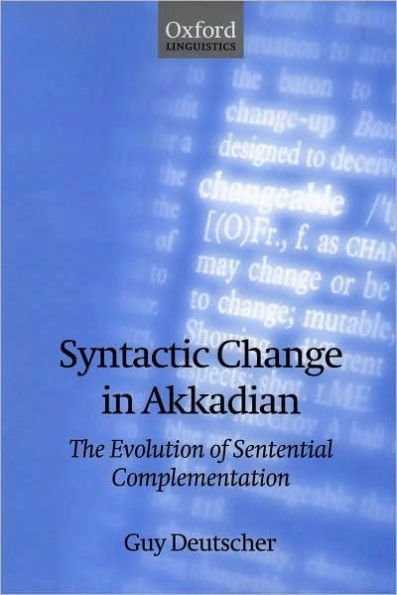Akkadian is one of the earliest attested languages and the oldest recorded Semitic language. It exists in written record between 2500BC and 500BC, much of it in letters and reports concerned with domestic and business matters, and written in colloquial language. It provides a unique and valuable source for the study of linguistic change but which, perhaps because of the impenetrability of its writing system, has rarely been exploited by linguists. In this book, Guy Deutscher examines the historical development of subordinate structures in Akkadian. A case study comprises the first two parts of the book, presenting an historical grammar of sentential complementation. Part I traces the emergence of new structures and describes how the finite complements first emerged in Babylonian. It also explains the grammaticalization of the quotative construction. Part II is a functional history which examines the changes in the functional roles of different structures. It shows how, during the history of the language, finite complements and embedded questions became more widespread, whereas other structures (e.g. infinite complements, parataxis, etc.) receded. Part III seeks to explain the historical developments in a theoretical light, showing how the development in Akkadian is mirrored in many other languages. It goes on to suggest that the emergence of finite complementation may be seen as 'adaptive' and related to the development of more complex communication patterns. This book will be of interest to both specialists and general linguists alike. For specialists it offers a contribution towards a badly-needed historical grammar of the Akkadian language. For general linguists this book will be of interest not only for the questions which it raises about the nature of complementation, but also for the window which it provides on to this little-known language.
"1111440882"
Syntactic Change in Akkadian: The Evolution of Sentential Complementation
Akkadian is one of the earliest attested languages and the oldest recorded Semitic language. It exists in written record between 2500BC and 500BC, much of it in letters and reports concerned with domestic and business matters, and written in colloquial language. It provides a unique and valuable source for the study of linguistic change but which, perhaps because of the impenetrability of its writing system, has rarely been exploited by linguists. In this book, Guy Deutscher examines the historical development of subordinate structures in Akkadian. A case study comprises the first two parts of the book, presenting an historical grammar of sentential complementation. Part I traces the emergence of new structures and describes how the finite complements first emerged in Babylonian. It also explains the grammaticalization of the quotative construction. Part II is a functional history which examines the changes in the functional roles of different structures. It shows how, during the history of the language, finite complements and embedded questions became more widespread, whereas other structures (e.g. infinite complements, parataxis, etc.) receded. Part III seeks to explain the historical developments in a theoretical light, showing how the development in Akkadian is mirrored in many other languages. It goes on to suggest that the emergence of finite complementation may be seen as 'adaptive' and related to the development of more complex communication patterns. This book will be of interest to both specialists and general linguists alike. For specialists it offers a contribution towards a badly-needed historical grammar of the Akkadian language. For general linguists this book will be of interest not only for the questions which it raises about the nature of complementation, but also for the window which it provides on to this little-known language.
41.99
In Stock
5
1

Syntactic Change in Akkadian: The Evolution of Sentential Complementation

Syntactic Change in Akkadian: The Evolution of Sentential Complementation
eBook
$41.99
$55.99
Save 25%
Current price is $41.99, Original price is $55.99. You Save 25%.
Related collections and offers
41.99
In Stock

Product Details
| ISBN-13: | 9780191544835 |
|---|---|
| Publisher: | OUP Oxford |
| Publication date: | 11/09/2000 |
| Sold by: | Barnes & Noble |
| Format: | eBook |
| File size: | 7 MB |
About the Author
From the B&N Reads Blog
